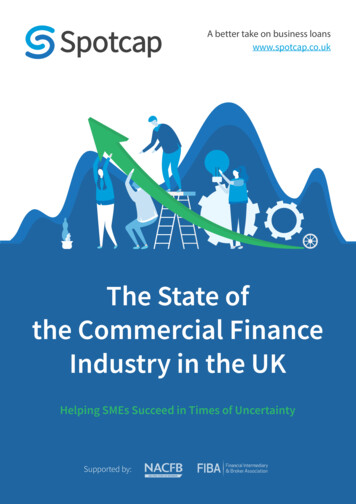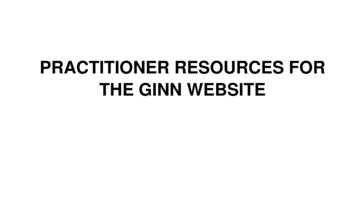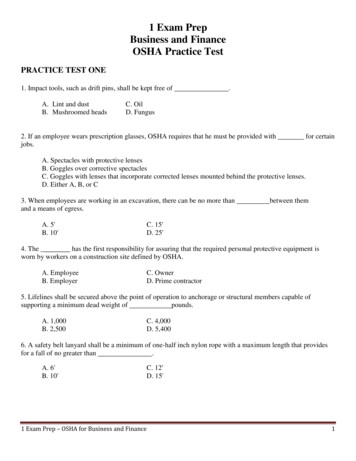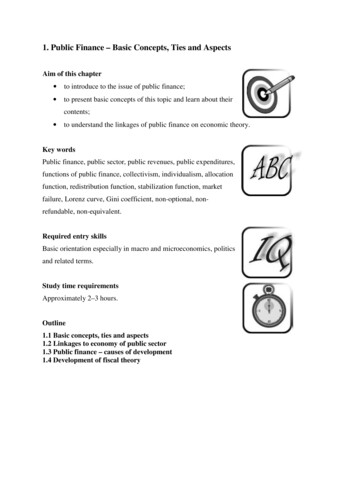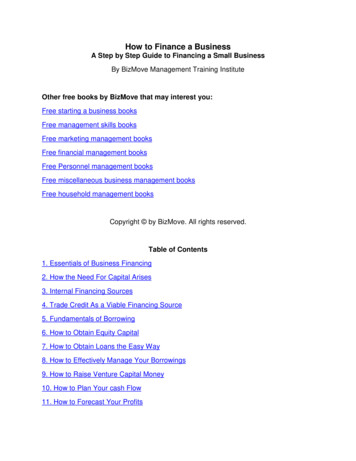
Transcription
How to Finance a BusinessA Step by Step Guide to Financing a Small BusinessBy BizMove Management Training InstituteOther free books by BizMove that may interest you:Free starting a business booksFree management skills booksFree marketing management booksFree financial management booksFree Personnel management booksFree miscellaneous business management booksFree household management booksCopyright by BizMove. All rights reserved.Table of Contents1. Essentials of Business Financing2. How the Need For Capital Arises3. Internal Financing Sources4. Trade Credit As a Viable Financing Source5. Fundamentals of Borrowing6. How to Obtain Equity Capital7. How to Obtain Loans the Easy Way8. How to Effectively Manage Your Borrowings9. How to Raise Venture Capital Money10. How to Plan Your cash Flow11. How to Forecast Your Profits
12. How to Plan for Future Financing Needs1. Essentials of Business FinancingThis chapter looks at the sources of capital that is available to a business.Types and Sources of CapitalCapital management and capital budgeting to finance a business has two majorforms: debt and equity. Creditor money (debt) comes from trade credit, loans made byfinancial institutions, leasing companies, and customers who have made prepaymentson larger-frequently manufactured orders. Equity is money received by the company inexchange for some portion of ownership. Sources include the entrepreneur's ownmoney; money from family, friends, or other non-professional investors; or money fromventure capitalists.Debt capital, depending upon its sources (e.g., trade, bank, leasing company, mortgagecompany) comes into the business for short or intermediate periods. Owner or equitycapital remains in the company for the life of the business (unless replaced by otherequity) and is repaid only when and if there is a surplus at liquidation of the business after all creditors are repaid.Acquiring such funds depends entirely on the business's ability to repay with interest(debt) or appreciation (equity). Financial performance (reflected in the FinancialStatements) and realistic, thorough management planning and control (shown by ProFormas and Cash Flow Budgets), are the determining factors in whether or not abusiness can attract the debt and equity funding it needs to operate and expand.Business capital can be further classified as equity capital, working capital, and growthcapital. Equity capital is the cornerstone of the financial structure of any company.Equity is technically the part of the Balance Sheet reflecting the ownership of thecompany. It represents the total value of the business, all other financing being debt thatmust be repaid. Usually, you cannot get equity capital at least not during the earlystages of business growth.Working capital is required to meet the continuing operational needs of the business,such as "carrying" accounts receivable, purchasing inventory, and meeting the payroll.In most businesses, these needs vary during the year, depending on activities(inventory build-up, seasonal hiring or layoffs, etc.) during the business cycle.Growth capital is not directly related to cyclical aspects of the business. Growth capitalis required when the business is expanding or being altered in some significant andcostly way that is expected to result in higher and increased cash flow. Lenders ofgrowth capital frequently depend on anticipated increased profit for repayment over anextended period of time, rather than expecting to be repaid from seasonal increases inliquidity as is the case of working capital lenders.
Every growing business needs all three types: equity, working, and growth capital. Youshould not expect a single financing program maintained for a short period of time toeliminate future needs for additional capital.As lenders and investors analyze the requirements of your business, they willdistinguish between the three types of capital in the following way:1) fluctuating needs (working capital);2) needs to be repaid with profits over a period of a few years (growth capital); and3) permanent needs (equity capital).If you are asking for a working capital loan, you will be expected to show how the loancan be repaid through cash (liquidity) during the business's next full operating cycle,generally a one year cycle. If you seek growth capital, you will be expected to show howthe capital will be used to increase your business enough to be able to repay the loanwithin several years (usually not more than seven). If you seek equity capital, it must beraised from investors who will take the risk for dividend returns or capital gains, or aspecific share of the business.Borrowing Working CapitalWorking capital is defined as the difference between current assets and currentliabilities. To the extent that a business does not generate enough money to pay tradedebt as it comes due, this cash must be borrowed.Commercial banks obviously are the largest source of such loans, which have thefollowing characteristics:The loans are short-term but renewable;they may fluctuate according to seasonal needs or follow a fixed schedule of repayment(amortization);they require periodic full repayment ("clean up");they are granted primarily only when the ratio of net current assets comfortably exceedsnet current liabilities; andthey are sometimes unsecured but more often secured by current assets (e.g., accountsreceivable and inventory).Advances can usually be obtained for as much as 70 to 80 percent of quality (likely tobe paid) receivables and to 40 to 50 percent of inventory. Banks grant unsecured creditonly when they feel the general liquidity and overall financial strength of a businessprovide assurance for repayment of the loan.You may be able to predict a specific interval, say three to five months, for which youneed financing. A bank may then agree to issue credit for a specific term. Most likely,you will need working capital to finance outflow peaks in your business cycle. Working
capital then supplements equity. Most working capital credits are established on a oneyear basis.Although most unsecured loans fall into the one-year line of credit category, anotherfrequently used type, the amortizing loan, calls for a fixed program of reduction, usuallyon a monthly or quarterly basis. For such loans your bank is likely to agree to termslonger than a year, as long as you continue to meet the principal reduction schedule.It is important to note that while a loan from a bank for working capital can be negotiatedonly for a relatively short term, satisfactory performance can allow the arrangement tobe continued indefinitely.Most banks will expect you to pay off your loans once a year (particularly if they areunsecured) in perhaps 30 or 60 days. This is known as "the annual clean up," and itshould occur when the business has the greatest liquidity. This debt reduction normallyfollows a seasonal sales peak when inventories have been reduced and mostreceivables have been collected.You may discover that it becomes progressively more difficult to repay debt or "cleanup" within the specified time. This difficulty usually occurs because:Your business is growing and its current activity represents a considerable increaseover the corresponding period of the previous year;you have increased your short-term capital requirement because of new promotionalprograms or additional operations; oryou are experiencing a temporary reduction in profitability and cash flow.Frequently, such a condition justifies obtaining both working capital and amortizingloans. For example, you might try to arrange a combination of a 15,000 open line ofcredit to handle peak financial requirements during the business cycle and 20,000 inamortizing loans to be repaid at, say 4,000 per quarter. In appraising such a request, acommercial bank will insist on justification based on past experience and futureprojections. The bank will want to know: How the 15,000 line of credit will be selfliquidating during the year (with ample room for the annual clean up); and how yourbusiness will produce increased profits and resulting cash flow to meet the schedule ofamortization on the 20,000 portion in spite of increasing your business's interestexpense.Borrowing Growth CapitalLenders expect working capital loans to be repaid through cash generated in the shortterm operations of the business, such as, selling goods or services and collectingreceivables. Liquidity rather than overall profitability supports such borrowing programs.Growth capital loans are usually scheduled to be repaid over longer periods with profitsfrom business activities extending several years into the future. Growth capital loansare, therefore, secured by collateral such as machinery and equipment, fixed assets
which guarantee that lenders will recover their money should the business be unable tomake repayment.For a growth capital loan you will need to demonstrate that the growth capital will beused to increase your cash flow through increased sales, cost savings, and/or moreefficient production. Although your building, equipment, or machinery will probably beyour collateral for growth capital funds, you will also be able to use them for generalbusiness purposes, so long as the activity you use them for promises success. Even ifyou borrow only to acquire a single piece of new equipment, the lender is likely to insistthat all your machinery and equipment be pledged.Instead of bank financing a particular piece of new equipment, it may be possible toarrange a lease. You will not actually own the equipment, but you will have exclusiveuse of it over a specified period. Such an arrangement usually has tax advantages. Itlets you use funds that would be tied up in the equipment, if you had purchased it. Italso affords the opportunity to make sure the equipment meets your needs before youpurchase it.Major equipment may also be purchased on a time payment plan, sometimes called aConditional Sales Purchase. Ownership of the property is retained by the seller until thebuyer has made all the payments required by the contract. (Remember, however, thattime payment purchases usually require substantial down payments and even leasesrequire cash advances for several months of lease payments.)Long-term growth capital loans for more than five but less than fifteen years are alsoobtainable. Real estate financing with repayment over many years on an establishedschedule is the best example. The loan is secured by the land and/or buildings themoney was used to buy. Most businesses are best financed by a combination of thesevarious credit arrangements.When you go to a bank to request a loan, you must be prepared to present yourcompany's case persuasively. You should bring your financial plan consisting of a CashBudget for the next twelve months, Pro Forma Balance Sheets, and Income Statementsfor the next three to five years. You should be able to explain and amplify thesestatements and the underlying assumptions on which the figures are based. Obviously,your assumptions must be convincing and your projections supportable. Finally, manybanks prefer statements audited by an outside accountant with the accountant's signedopinion that the statements were prepared in accordance with generally acceptedaccounting principles and that they fairly present the financial condition of yourbusiness.Borrowing Permanent Equity CapitalPermanent capital sometimes comes from sources other than the businessowner/manager.Venture capital, another source of equity capital, is extremely difficult to define;however, it is high risk capital offered with the principal objective of earning capital gainsfor the investor. While venture capitalists are usually prepared to wait longer than the
average investor for a profitable return, they usually expect in excess of 15 percentreturn on their investment Often they expect to take an active part in determining theobjectives of the business. These investors may also assist the small businessowner/manager by providing experienced guidance in marketing, product ideas, andadditional financing alternatives as the business develops. Even though turning toventure capital may create more bosses, their advice could be as valuable as themoney they lend. Be aware, however, that venture capitalists are looking for businesseswith real potential for growth and for future sales in the millions of dollars.Applying for CapitalBelow is the minimum information you must make available to lenders and investors:1. Discussion of the BusinessName, address, and telephone number.Type of business you are in now or want to expand or start.2. Amount of Money You Need to BorrowAsk for all you will need. Don't ask for a part of the total and think you can come backfor more later. This could indicate to the lender that you are a poor planner.3. How You Will Use the MoneyList each way the borrowed money will be used.Itemize the amount of money required for each purpose.4. Proposed Terms of the LoanInclude a payback schedule. Even though the lender has the final say in setting theterms of the loan, if you suggest terms, you will retain a negotiating position.5. Financial Support DocumentsShow where the money will come from to repay the loan through the following projectedstatements:Profit and Loss Statements (one year for working capital loan requests and three to fiveyears for growth capital requests)Cash Flow Statements (one year for working capital loan requests and three to fiveyears for growth capital requests)6. Financial History of the BusinessInclude the following financial statements for the last three years:Balance Sheet
Profit and Loss StatementAccounts Receivable and Accounts Payable Listings and Agings7.Personal Financial Statement of the Owner(s)Personal Assets and LiabilitiesResume(s)8. Other Useful Information IncludesLetters of Intent from Prospective CustomersLeases or Buy/Sell Agreements Affecting Your BusinessReference LettersAlthough it is not required, it is useful to calculate the ratios described earlier in thissection for your business over the past three years. Use this information to prove thestrong financial health and good trends in your business's development and todemonstrate that you use such management tools to plan and control your business'sgrowth.Go to Top2. How the Need For Capital ArisesThere is more than one way to skin a cat. You'd better remember this old adage whenyour business needs more inventory, personnel, and facilities. As your business grows,so does your need for more and more capital. Remember there is more than one wayand more than one place to raise the money you need.Causes of Additional Capital NeedsThere are many factors that can create a need for additional capital. Some of the morecommon are as follows:Sales growth requires inventories to be built to support the higher sales level.Sales growth creates a larger volume of accounts receivableGrowth requires the business to carry larger cash balances in order to meet its currentobligations to employees, trade creditors, and others.Expansion opportunities such as a decision to open a new branch, add a new product,or increase capacity.Cost savings opportunities such as equipment purchases that will lower productioncosts or reduce operating expenses.
Opportunities to realize substantial savings by taking advantage of quantity discountson purchases for inventory, or building inventories prior to a supplier's price increaseSeasonal factors, where inventories must be built before the selling season begins andreceivables may not be collected until 30 to 60 days after the selling season ends.Current repayment of obligations or debts may require more cash than is immediatelyavailable.Local or national economic conditions which cause sales and profit to declinetemporarily.Economic difficulties of customers that can cause them to pay more slowly thanexpected.Failure to retain sufficient earnings in the business.Inattention to asset management may have allowed inventories or accounts receivableto get out of hand.CombinationFrequently, the cause cannot be entirely attributed to any one of these factors, butresults from a combination. For example, a growing, apparently successful businessmay find that it does not have sufficient cash on hand to meet a current debt installmentor to expand to a new location because customers have been slow in paying.Short- and Long-Term CapitalCapital needs can be classified as either short- or long-term. Short-term needs aregenerally those of less than one year. Long-term needs are those of more than oneyear.Short-term FinancingShort-term financing is most common for assets that turn over quickly such as accountsreceivable or inventories. Seasonal businesses that must build inventories inanticipation of selling requirements and will not collect receivables until after the sellingseason often need short-term financing for the interim. Contractors with substantialwork-in-process inventories often need short-term financing until payment is received.Wholesalers and manufacturers with a major portion of their assets tied up ininventories and/or receivables also require short-term financing in anticipation ofpayments from customers.Long-term FinancingLong-term financing is more often associated with the need for fixed assets such asproperty, plant, and equipment where the assets will be used in the business for severalyears. It is also a practical alternative in many situations where short-term financingrequirements recur on a regular basis.
Recurring NeedsA series of short-term needs could often be more realistically viewed as a long-termneed. The addition of long-term should eliminate the short-term needs and the crisesthat could occur if capital were not available to meet a short-term need.Steady GrowthWhenever the need for additional capital grows continually without any significantpattern, as in the case of a company with steady sales and profit from year to year,long-term financing is probably more appropriate.Go to Top3. Internal Financing SourcesInternal sources of capital are those generated within the business. External sources ofcapital are those outside the business such as suppliers, lenders, and investors.For example, a business can generate capital internally by accelerating collection ofreceivables, disposing of surplus inventories, retaining profit in the business, or cuttingcosts.Capital can be generated externally by borrowing or locating investors who might beinterested in buying a portion of the business.Internal Financing SourcesBefore seeking external sources of capital from investors or lenders, a business shouldthoroughly explore all reasonable sources for meeting its capital needs internally. Evenif this effort fails to generate all of the needed capital, it can sharply reduce the externalfinancing requirement, resulting in less interest expense, lower repayment obligations,and less sacrifice of control. With a lower requirement, the business' ability to secureexternal financing will be improved. Further, the ability to generate maximum capitalinternally and to control operations will enhance the confidence of outside investors andlenders. With more confidence in the business and its management, lenders andinvestors will be more willing to commit their capital.Basic SourcesBasically, there are three principal sources of internal capital. These are as follows:Increasing the amount of earnings kept in the business.Prudent asset management.Cost control.Increased Earnings Retention
Many businesses are able to meet all of their capital needs through earnings retention.Each year, shareholders' dividends or partners' drawings are restricted so that thelargest reasonable share of earnings is retained in the business to finance its growth.As with other internal capital sources, earnings retention not only reduces any externalcapital requirement, but also affects the business' ability to secure external capital.Lenders are particularly concerned with the rate of earnings retention, since the abilityto repay debt obligations normally depends upon the amount of cash generated throughoperations. If this cash is used excessively to pay dividends or to permit withdrawals byinvestors, the company's ability to meet its debt obligations will be threatened.Asset ManagementMany businesses have non-productive assets that can be liquidated (sold or collected)to provide capital for short-term needs. A vigorous campaign of collecting outstandingreceivables, with particular emphasis on amounts long outstanding, can often producesignificant amounts of capital. Similarly, inventories can be analyzed and those goodswith relatively slow sales activity or with little hope for future fast movement can beliquidated. The liquidation can occur through sales to customers or through sales towholesale outlets, as required.Fixed assets can be sold to free cash immediately. For example, a company automobilemight be sold and provide cash of 5,000 or 8,000. Owners and employees can becompensated on an actual mileage basis for use of their personal cars on companybusiness. Or if an automobile is needed on a full-time basis, a lease can be arranged sothat a vehicle will be available. Other assets such as loans made by the business toofficers or employees, investments in non-related businesses, or prepaid expensesshould be analyzed closely. If they are nonproductive, they can often be liquidated sothat cash is available to meet the immediate needs of the business.Any of the above steps can be taken to alleviate short-term cash shortages.On a long-term basis, the business can minimize its external capital needs byestablishing policies and procedures that will reduce the possibility of cash shortagescaused by ineffective asset management. These policies could include theestablishment of more rigorous credit standards, systematic review of outstandingreceivables, periodic analysis of slow-moving inventories, and establishment ofprofitability criteria so that fixed asset investments are more closely controlled.Cost ReductionCareful analysis of costs, both before and after the fact, can improve profitability andtherefore the amount of earnings available for retention. At the same time, cost controlminimizes the need for cash to meet obligations to trade creditors and others.Before the fact, a business can establish buying controls that require a written purchaseorder and competitive bids on all purchases above a specified amount. Decisions to hireextra personnel, lease additional space, or incur other additional costs can be reviewedclosely before commitments are made.
After the fact, management should review all actual costs carefully. Expenses can becompared with objectives, experience in previous periods, or with other companies inthe industry. Whenever an apparent excess is identified, the cause of the excess shouldbe closely explored and corrective action taken to prevent its recurrence.Go to Top4. Trade Credit as a Viable Financing SourceTrade credit is credit extended by suppliers. Ordinarily, it is the first source of extracapital that the small business owner turns to when the need arises.Informal ExtensionsFrequently, this is done with no formal planning by the business. Suppliers' invoices aresimply allowed to "ride" for another 30 to 60 days. Unfortunately, this can lead to anumber of problems. Suppliers may promptly terminate credit and refuse to deliver untilthe account is settled, thus denying the business access to sorely needed supplies,materials, or inventory. Or, suppliers might put the business on a C.O.D. basis, requiringthat all shipments be fully paid in cash immediately upon receipt. At a time when abusiness is obviously strapped for cash, this requirement could have the same effect ascutting off deliveries altogether.Planning AdvantagesA planned program of trade credit extensions can often help the business secure extracapital that it needs without recourse to lenders or equity investors. This is particularlytrue whenever the capital need is relatively small or short in duration.A planned approach should involve the following:Take full advantage of available payment terms. If no cash discount is offered andpayment is due on the 30th day, do not make any payments before the 30th day.Whenever possible, negotiate extended payment terms with suppliers. For example, if asupplier's normal payment terms are net 30 days from the receipt of goods, these couldbe extended to net 30 days from the end of the month. This effectively "buys" anaverage of 15 extra days.If the business feels that it needs a substantial increase in time, say 60 to 90 days, itshould advise suppliers of this need. They will often be willing to accept it, provided thatthe business is faithful in its adherence to payment at the later date.Consider the effect of cash discounts and delinquency penalties for late payment.Frequently, the added cost of trade credit may be far more expensive than the cost ofalternate financing such as a short-term bank loan.
Consider the possibility signing a note for each shipment promising payment at aspecific later date. Such a note, which may or may not be interest-bearing, would givethe supplier evidence of your intent to pay and increase the supplier’s confidence inyour business.Ready AvailabilityTrade credit is often available to businesses on a relatively informal basis without therequirements for application, negotiation, auditing, and legal assistance often necessarywith other capital sources.UsageTrade credit must be used judiciously. Its easy availability is particularly welcome inbrief periods of limited needs. Used imprudently, however, it can lead to curtailment ofrelations with key suppliers and jeopardize your ability to locate other, competitivesuppliers who are willing to extend credit to your business.Go to Top5. Fundamentals of BorrowingDebt capital is an amount of money borrowed from a creditor. The amount borrowed isusually evidenced by a note, signed by the borrower, agreeing to repay the principalamount borrowed plus interest on some predetermined basis.Borrowing TermThe terms under which money is borrowed may vary widely. Short-term notes can beissued for periods as brief as 10 days to fill an immediate need. Long-term notes can beissued for a period of several years.Payment ScheduleWhen the terms of a debt are negotiated, a payment schedule is established for bothinterest obligations and principal repayment.Discounted NotesIn some cases, particularly in short-term borrowing, the total amount of interest due overthe term of the note is deducted from the principal before the proceeds are issued to theborrower. Such a note is called a discounted note.Short-term BorrowingShort-term borrowing usually requires repayment within 60 to 90 days. Notes are oftenrenewed, in whole or in part, on the due date, provided that the borrower has lived up tothe obligations of the original agreement and the business continues to be a favorablelending risk.
AvailabilityCommercial banks are the ordinary source of short-term loans for small businesses.Credit LinesWhen a business has established itself as being worthy of short-term credit, and theamount needed fluctuates from time to time, banks will often establish a line of creditwith the business. The line of credit is the maximum amount that the business canborrow at any one time. The exact amount borrowed can vary according to the needs ofthe business but cannot exceed its established credit line.These arrangements give the business access to its requirements up to the credit limit,or line. However, it pays interest only on the actual amount borrowed, not the entire lineof credit available to it.Long-term DebtLong-term debt is borrowing for a period greater than one year. This generalclassification includes "intermediate debt" which is borrowing for periods of one to 10years.Small Business ApplicationsFor small businesses, borrowed capital for periods greater than 10 years is usuallyavailable only on real estate mortgages. Other long-term borrowing usually falls into the"intermediate" classification and is available for periods up to 10 years. Such loans arecalled "term loans."Mortgage Payment SchedulesPrincipal and interest payments on mortgages usually involve uniform monthlypayments that include both principal and interest.Each successive monthly payment reduces the amount of principal outstanding.Therefore, the amount of interest owed decreases and the portion of the monthlypayment applicable to principal increases. In the early years of a mortgage, the portionof the monthly payment applied against the principal is relatively small, but grows witheach payment.Term Loan Payment SchedulesFor term loans, payment of principal and interest is ordinarily scheduled on an annual,semiannual, or quarterly basis. For example, a 5-year, 50,000 term note bearing 10%interest might have the following payment schedule specified in the note agreement:
Repayment SchedulesThe dates on which principal and interest payments are due should be scheduledcarefully. For example, a manufacturer with heavy sales just before Christmas andreceivables collections through January might best be able to schedule repayments inFebruary. If a payment were due in October or November, when inventories were highand receivables were climbing, the payment could be crippling.CollateralLoans may be secured or unsecured. In a secured loan, the borrower pledges certainassets as collateral (security) to protect the lender in case of default on the loan orfailure of the business. If the business defaults on the loan through failure to meetinterest obligations or principal repayments, the note-holder (lender) assumesownership of the collateral. If the business fails, the note-holder claims ownership ofthose specific assets pledged as collateral before the claims of other creditors
to finance a business has two major forms: debt and equity. Credit or money (debt) comes from trade credit, loans made by financial institutions, leasing companies, and customers who have made prepayments on larger-frequently manufactured orders. Equity is money received



